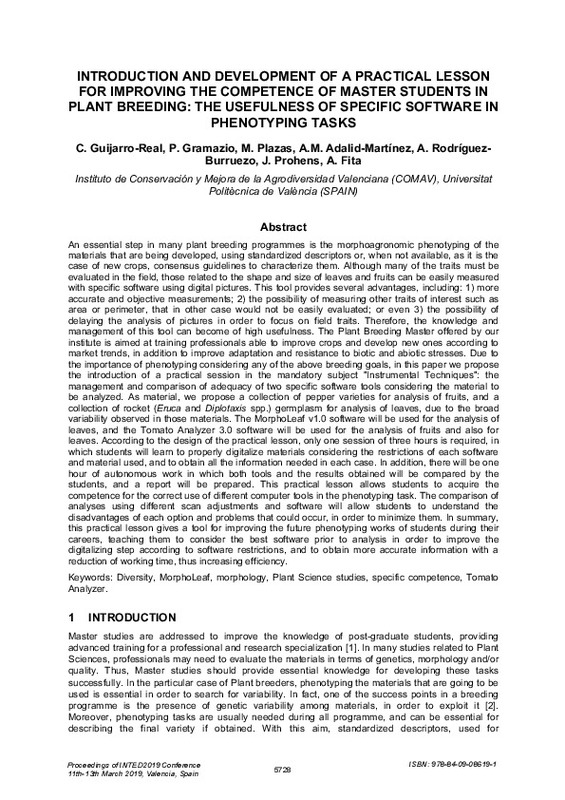|
Resumen:
|
[EN] An essential step in many plant breeding programmes is the morphoagronomic phenotyping of the materials that are being developed, using standardized descriptors or, when not available, as it is the case of new crops, ...[+]
[EN] An essential step in many plant breeding programmes is the morphoagronomic phenotyping of the materials that are being developed, using standardized descriptors or, when not available, as it is the case of new crops, consensus guidelines to characterize them. Although many of the traits must be evaluated in the field, those related to the shape and size of leaves and fruits can be easily measured with specific software using digital pictures. This tool provides several advantages, including: 1) more accurate and objective measurements; 2) the possibility of measuring other traits of interest such as area or perimeter, that in other case would not be easily evaluated; or even 3) the possibility of delaying the analysis of pictures in order to focus on field traits. Therefore, the knowledge and management of this tool can become of high usefulness. The Plant Breeding Master offered by our institute is aimed at training professionals able to improve crops and develop new ones according to market trends, in addition to improve adaptation and resistance to biotic and abiotic stresses. Due to the importance of phenotyping considering any of the above breeding goals, in this paper we propose the introduction of a practical session in the mandatory subject "Instrumental Techniques": the management and comparison of adequacy of two specific software tools considering the material to be analyzed. As material, we propose a collection of pepper varieties for analysis of fruits, and a collection of rocket (Eruca and Diplotaxis spp.) germplasm for analysis of leaves, due to the broad variability observed in those materials. The MorphoLeaf v1.0 software will be used for the analysis of leaves, and the Tomato Analyzer 3.0 software will be used for the analysis of fruits and also for leaves. According to the design of the practical lesson, only one session of three hours is required, in which students will learn to properly digitalize materials considering the restrictions of each software and material used, and to obtain all the information needed in each case. In addition, there will be one hour of autonomous work in which both tools and the results obtained will be compared by the students, and a report will be prepared. This practical lesson allows students to acquire the competence for the correct use of different computer tools in the phenotyping task. The comparison of analyses using different scan adjustments and software will allow students to understand the disadvantages of each option and problems that could occur, in order to minimize them. In summary, this practical lesson gives a tool for improving the future phenotyping works of students during their careers, teaching them to consider the best software prior to analysis in order to improve the digitalizing step according to software restrictions, and to obtain more accurate information with a reduction of working time, thus increasing efficiency.
[-]
|
|
Agradecimientos:
|
Carla Guijarro-Real is grateful to the Ministerio de Educación, Cultura y Deporte of Spain for a
predoctoral FPU grant (FPU14-06798). Pietro Gramazio is grateful to Universitat Politècnica de
València for a post-doctoral ...[+]
Carla Guijarro-Real is grateful to the Ministerio de Educación, Cultura y Deporte of Spain for a
predoctoral FPU grant (FPU14-06798). Pietro Gramazio is grateful to Universitat Politècnica de
València for a post-doctoral contract (PAID-10-18) within the Programa de Ayudas de Investigación y
Desarrollo initiative. Mariola Plazas is grateful to Generalitat Valenciana and Fondo Social Europeo for
a post-doctoral grant (APOSTD/2018/014). Ana M Adalid-Martínez is grateful to the Ministerio de
Ciencia, Innovación y Universidad of Spain for its support with a post-doctoral contract (PTA2015-
11502-I) within the Subprograma Personal Técnico de Apoyo initiative.
[-]
|









